Page 46 of 436
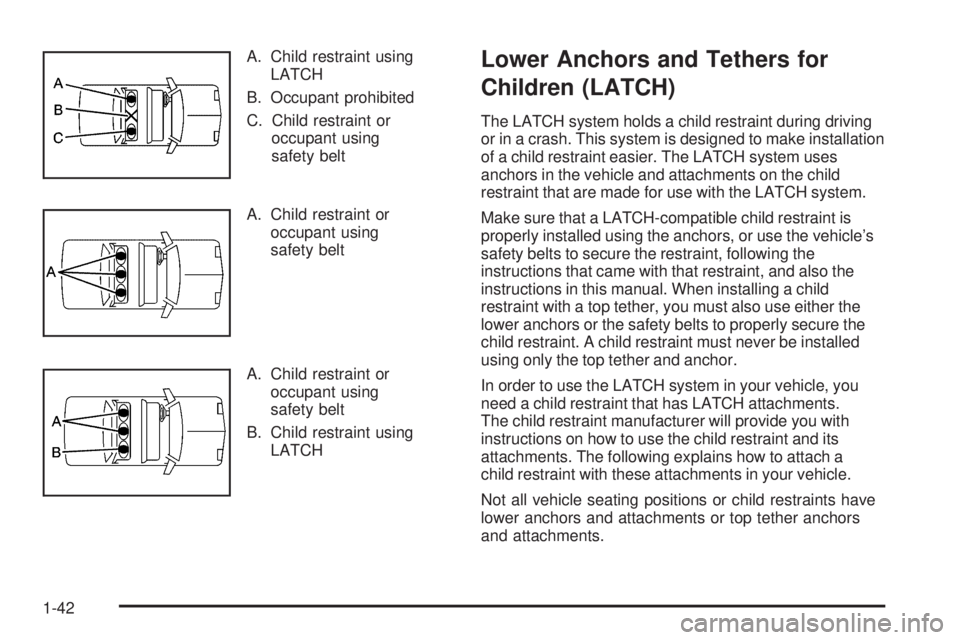
A. Child restraint using
LATCH
B. Occupant prohibited
C. Child restraint or
occupant using
safety belt
A. Child restraint or
occupant using
safety belt
A. Child restraint or
occupant using
safety belt
B. Child restraint using
LATCHLower Anchors and Tethers for
Children (LATCH)
The LATCH system holds a child restraint during driving
or in a crash. This system is designed to make installation
of a child restraint easier. The LATCH system uses
anchors in the vehicle and attachments on the child
restraint that are made for use with the LATCH system.
Make sure that a LATCH-compatible child restraint is
properly installed using the anchors, or use the vehicle’s
safety belts to secure the restraint, following the
instructions that came with that restraint, and also the
instructions in this manual. When installing a child
restraint with a top tether, you must also use either the
lower anchors or the safety belts to properly secure the
child restraint. A child restraint must never be installed
using only the top tether and anchor.
In order to use the LATCH system in your vehicle, you
need a child restraint that has LATCH attachments.
The child restraint manufacturer will provide you with
instructions on how to use the child restraint and its
attachments. The following explains how to attach a
child restraint with these attachments in your vehicle.
Not all vehicle seating positions or child restraints have
lower anchors and attachments or top tether anchors
and attachments.
1-42
Page 50 of 436
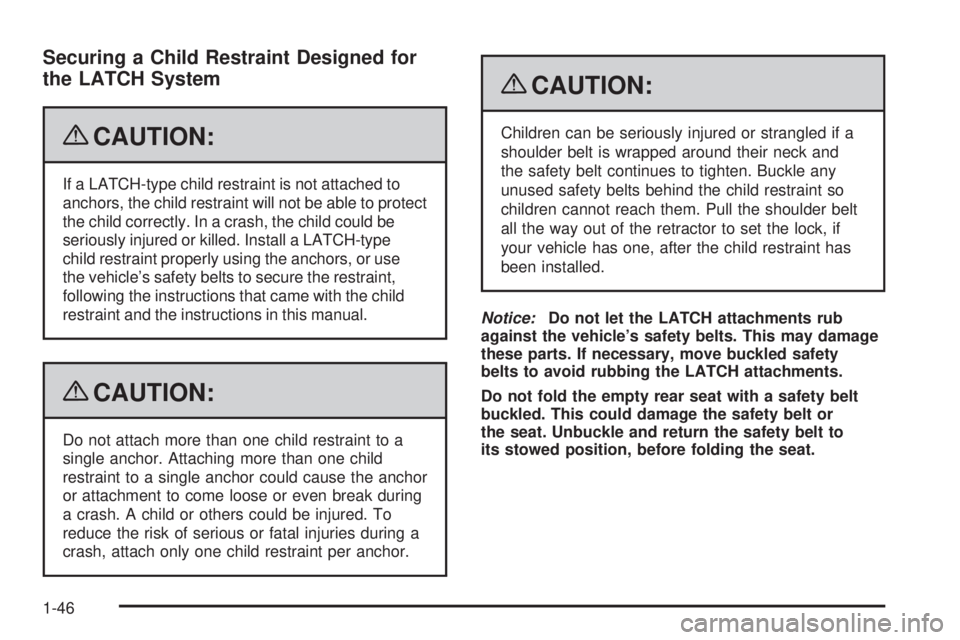
Securing a Child Restraint Designed for
the LATCH System
{CAUTION:
If a LATCH-type child restraint is not attached to
anchors, the child restraint will not be able to protect
the child correctly. In a crash, the child could be
seriously injured or killed. Install a LATCH-type
child restraint properly using the anchors, or use
the vehicle’s safety belts to secure the restraint,
following the instructions that came with the child
restraint and the instructions in this manual.
{CAUTION:
Do not attach more than one child restraint to a
single anchor. Attaching more than one child
restraint to a single anchor could cause the anchor
or attachment to come loose or even break during
a crash. A child or others could be injured. To
reduce the risk of serious or fatal injuries during a
crash, attach only one child restraint per anchor.
{CAUTION:
Children can be seriously injured or strangled if a
shoulder belt is wrapped around their neck and
the safety belt continues to tighten. Buckle any
unused safety belts behind the child restraint so
children cannot reach them. Pull the shoulder belt
all the way out of the retractor to set the lock, if
your vehicle has one, after the child restraint has
been installed.
Notice:Do not let the LATCH attachments rub
against the vehicle’s safety belts. This may damage
these parts. If necessary, move buckled safety
belts to avoid rubbing the LATCH attachments.
Do not fold the empty rear seat with a safety belt
buckled. This could damage the safety belt or
the seat. Unbuckle and return the safety belt to
its stowed position, before folding the seat.
1-46
Page 51 of 436
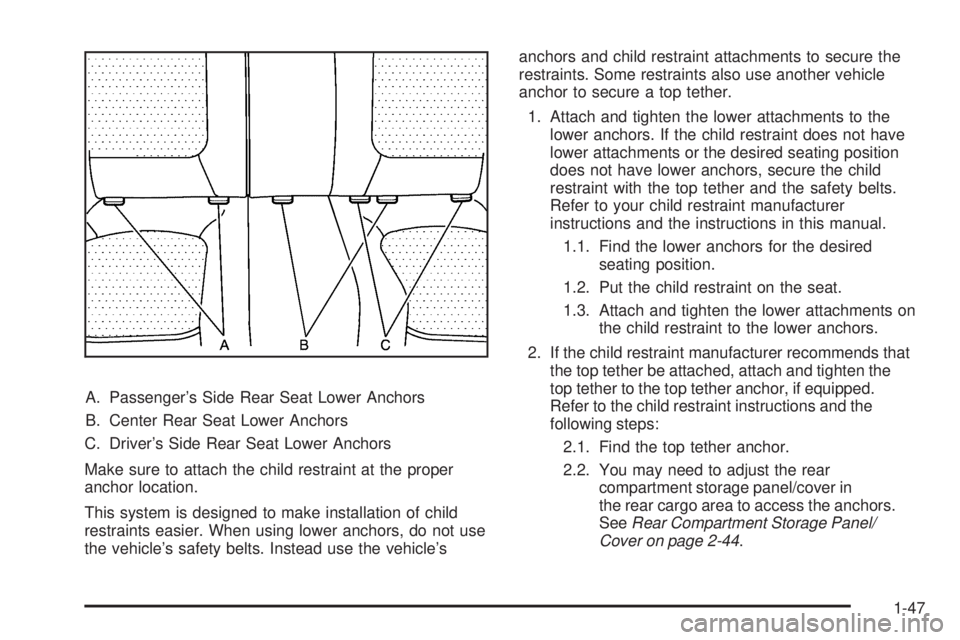
A. Passenger’s Side Rear Seat Lower Anchors
B. Center Rear Seat Lower Anchors
C. Driver’s Side Rear Seat Lower Anchors
Make sure to attach the child restraint at the proper
anchor location.
This system is designed to make installation of child
restraints easier. When using lower anchors, do not use
the vehicle’s safety belts. Instead use the vehicle’sanchors and child restraint attachments to secure the
restraints. Some restraints also use another vehicle
anchor to secure a top tether.
1. Attach and tighten the lower attachments to the
lower anchors. If the child restraint does not have
lower attachments or the desired seating position
does not have lower anchors, secure the child
restraint with the top tether and the safety belts.
Refer to your child restraint manufacturer
instructions and the instructions in this manual.
1.1. Find the lower anchors for the desired
seating position.
1.2. Put the child restraint on the seat.
1.3. Attach and tighten the lower attachments on
the child restraint to the lower anchors.
2. If the child restraint manufacturer recommends that
the top tether be attached, attach and tighten the
top tether to the top tether anchor, if equipped.
Refer to the child restraint instructions and the
following steps:
2.1. Find the top tether anchor.
2.2. You may need to adjust the rear
compartment storage panel/cover in
the rear cargo area to access the anchors.
SeeRear Compartment Storage Panel/
Cover on page 2-44.
1-47
Page 53 of 436
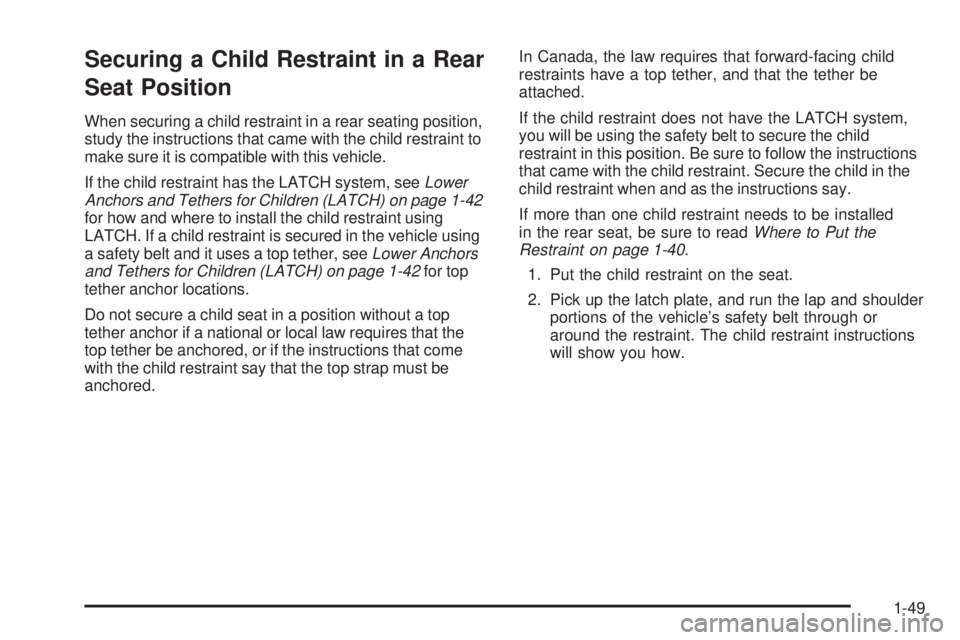
Securing a Child Restraint in a Rear
Seat Position
When securing a child restraint in a rear seating position,
study the instructions that came with the child restraint to
make sure it is compatible with this vehicle.
If the child restraint has the LATCH system, seeLower
Anchors and Tethers for Children (LATCH) on page 1-42
for how and where to install the child restraint using
LATCH. If a child restraint is secured in the vehicle using
a safety belt and it uses a top tether, seeLower Anchors
and Tethers for Children (LATCH) on page 1-42for top
tether anchor locations.
Do not secure a child seat in a position without a top
tether anchor if a national or local law requires that the
top tether be anchored, or if the instructions that come
with the child restraint say that the top strap must be
anchored.In Canada, the law requires that forward-facing child
restraints have a top tether, and that the tether be
attached.
If the child restraint does not have the LATCH system,
you will be using the safety belt to secure the child
restraint in this position. Be sure to follow the instructions
that came with the child restraint. Secure the child in the
child restraint when and as the instructions say.
If more than one child restraint needs to be installed
in the rear seat, be sure to readWhere to Put the
Restraint on page 1-40.
1. Put the child restraint on the seat.
2. Pick up the latch plate, and run the lap and shoulder
portions of the vehicle’s safety belt through or
around the restraint. The child restraint instructions
will show you how.
1-49
Page 54 of 436
3. Push the latch plate into the buckle until it clicks.
Position the release button on the buckle so that
the safety belt could be quickly unbuckled if
necessary.4. Pull the rest of the shoulder belt all the way out of
the retractor to set the lock.
1-50
Page 55 of 436
5. To tighten the belt, push down on the child restraint,
pull the shoulder portion of the belt to tighten the lap
portion of the belt and feed the shoulder belt back
into the retractor. When installing a forward-facing
child restraint, it may be helpful to use your knee
to push down on the child restraint as you tighten
the belt.6. If the child restraint has a top tether, follow the
child restraint manufacturer’s instructions regarding
the use of the top tether. SeeLower Anchors
and Tethers for Children (LATCH) on page 1-42
for more information.
7. Push and pull the child restraint in different
directions to be sure it is secure.
To remove the child restraint, unbuckle the vehicle safety
belt and let it return to the stowed position. If the top
tether is attached to a top tether anchor, disconnect it.
1-51
Page 57 of 436
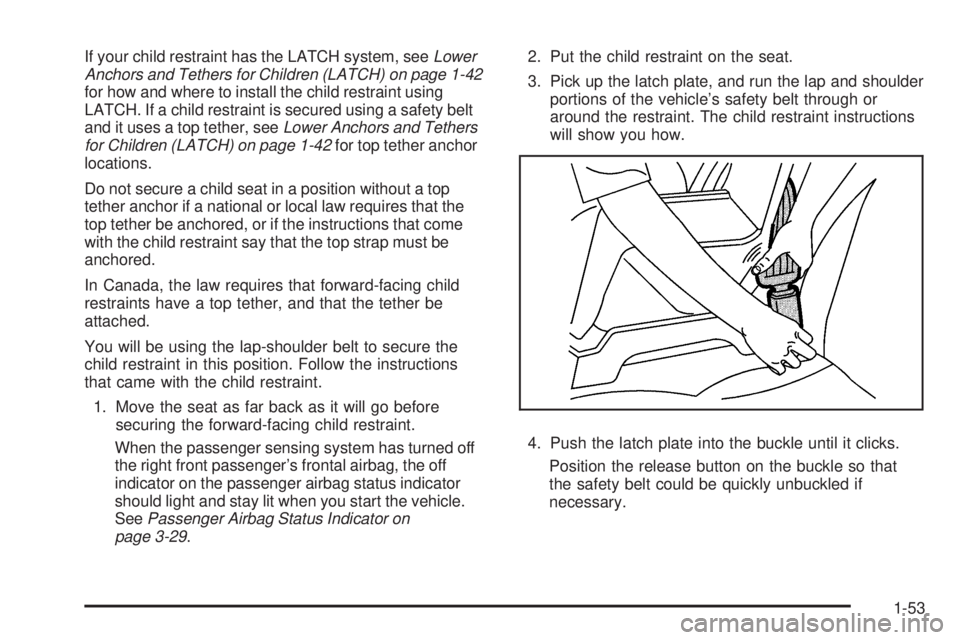
If your child restraint has the LATCH system, seeLower
Anchors and Tethers for Children (LATCH) on page 1-42
for how and where to install the child restraint using
LATCH. If a child restraint is secured using a safety belt
and it uses a top tether, seeLower Anchors and Tethers
for Children (LATCH) on page 1-42for top tether anchor
locations.
Do not secure a child seat in a position without a top
tether anchor if a national or local law requires that the
top tether be anchored, or if the instructions that come
with the child restraint say that the top strap must be
anchored.
In Canada, the law requires that forward-facing child
restraints have a top tether, and that the tether be
attached.
You will be using the lap-shoulder belt to secure the
child restraint in this position. Follow the instructions
that came with the child restraint.
1. Move the seat as far back as it will go before
securing the forward-facing child restraint.
When the passenger sensing system has turned off
the right front passenger’s frontal airbag, the off
indicator on the passenger airbag status indicator
should light and stay lit when you start the vehicle.
SeePassenger Airbag Status Indicator on
page 3-29.2. Put the child restraint on the seat.
3. Pick up the latch plate, and run the lap and shoulder
portions of the vehicle’s safety belt through or
around the restraint. The child restraint instructions
will show you how.
4. Push the latch plate into the buckle until it clicks.
Position the release button on the buckle so that
the safety belt could be quickly unbuckled if
necessary.
1-53
Page 58 of 436
5. Pull the rest of the shoulder belt all the way out of
the retractor to set the lock.6. To tighten the belt, push down on the child restraint,
pull the shoulder portion of the belt to tighten the lap
portion of the belt and feed the shoulder belt back
into the retractor. When installing a forward-facing
child restraint, it may be helpful to use your knee
to push down on the child restraint as you tighten
the belt.
1-54